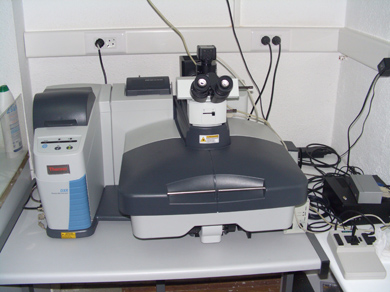Raman Spectroscopy Laboratory
* SCIENTIFIC EQUIPMENT

The Non-Destructive Techniques Service has a multifunctional Raman DXR RAMAN THERMO FISCHER microscope that allows to see and analyze, with Raman spectroscopy, different points of a sample at 1 micron of spatial resolution.
The microscope includes two lasers: one of 532 nm and the other of 780 nm of wavelength. The software, in conjunction with the motorized plate, allows spectral mapping.
It also works with confocality, allowing analysis of internal inclusions. In addition, the laboratory has fiber optics to analyze large samples that cannot be introduced into the microscope chamber.
It has a LINKAM plate to carry out analyses in temperatures between -196ºC and 600ºC.
* SESSIONS
In the Raman microscopy sessions it is possible to work with or without a specialized technician, in self-service mode, after prior training by the laboratory staff.
Sessions WITH technical assistance
The laboratory technicians try to adjust the schedule and the needs of the different working groups. For this, sessions of different lengths and schedules have been prepared to add more versatility and adjustment to the needs of the users with the laboratory’s agenda.
Sessions WITHOUT technical assistance
For a more efficient working, it is advisable not to exceed 6 hours of use per week and per person. If you need to use the service for a longer time, it may be extended after informing the service technicians, who will inform you about the availability of the equipment. In case of saturation of the service, users will be notified in advance of the reduction in the maximum reservation time.
User engagement
The users who are going to manage the equipment by themselves will have the first assisted session and, in the following sessions, they will be advised and helped by the technical personnel assigned to the service until they acquire autonomy in the development of the work. In case of any difficulties arising during the non-assisted session with the equipment, the laboratory technicians will be available to advise and to solve the problem. The users will notify the technical staff of any incidents that may have occurred during the handling of the equipment, especially those that may require the repair or maintenance of the equipment. All this will avoid inconveniences for users who want to use the equipment in the next session.
The more delicate routines and operations (laser calibrations, alignments, and changes) MUST be performed by laboratory technicians. Third party training by other users is neither advisable nor desirable.
The computer's hard drive is cleaned periodically every month. Users are advised to save their data on their external hard drive or pen drive once the session is over.
* CONDITIONS OF DELIVERY OF SAMPLES AND RESULTS
Since the user is normally present in the laboratory during the analysis, at the end of the session they will take their samples and the results obtained. When the user requests a routine session that the technicians can carry out without his presence, and always in agreement with him, the results, the report and the samples will be sent to him.
* PREPARATION OF THE SAMPLES FOR THE SESSION
The samples analyzed by this equipment can be solid, liquid or gaseous:
- Solid samples will be placed directly on a microscope slide that can be provided by the service. These samples may be assembled in the laboratory as long as the assembly does not involve more than placing and fixing them on the glass slide.
- Liquid and gaseous samples will be required to be brought in vials by the user, and they will be placed by the technician at the time of their observation.
* PRINCIPLES OF THE TECHNIQUE
DXR Raman spectroscopy coupled to a confocal microscope is a chemical technique that performs a vibrational, rotational and other low-frequency modes study of the system. This depends on the inelastic scattering, or Raman scattering of monochromatic light, usually from laser light in the visible, near infrared or ultraviolet range. Laser light interacts with photons or other excitations in the system causing increases and decreases in the energy of the system. These changes in energy give analytical information about the system. To facilitate the assignments of Raman bands, the free arizona web database rruff raman and the web of knowledge search system are used. The sample does not need to be prepared and only a small volume of the sample is required (<1 µm of diameter).
In the RAMAN spectroscopy sessions, it is possible to work with or without a specialist technician, in self-service mode, after prior advanced instruction by the laboratory staff.
Schedule
De 8:30 a 17:00
Staff
Laura Tormo Cifuentes
Marta Furió Vega
Cristina Paradela Guerrero
Pedro Valverde Lobato

